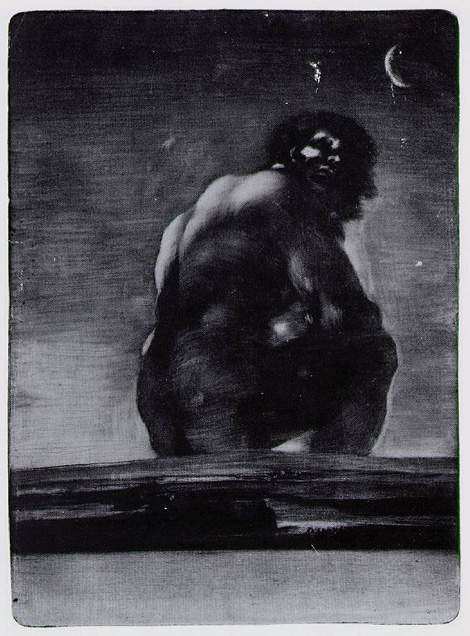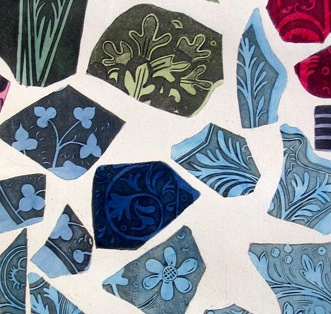Abriged version. For footnotes please see the more detailed German version.
6) Inner Africa
For Smith, the street cries pictures had a decisive advantage in comparison to the costume book. It was a speaking medium associated with the acoustic notion of original sound meant to suggest directness and authenticity. Every vendor was attributed a unique set of words with which he loudly offered his goods for sale. At times these cries were written in a dialect, and in some cases musical notations were even added to them.
Smith wanted to leave a largest possible stock of direct quotes to posterity. Like in a patchwork, he strings together dialogue upon dialogue in his publications, remembered fragment upon fragment, with the calculation of a scholar of antiquities. He left it to posterity to connect the dots of this pile of literary shards of unfiltered information to draw a picture of the times. It is the obsession of the archaeological draughtsman with the seemingly worthless, small individual parts, the minute particulars, that comes to light in Smith’s literary works.

J.T. Smith, Specimens of Stained Glass, in: Antiquities of Westminster, London 1817 (MePri-Coll.)

J.T. Smith, Specimens of Stained Glass, in: Antiquities of Westminster, London 1817 (MePri-Coll.)
The connection between antiquity studies, the collection of anecdotes and low genre art is also characteristic of the work of the street cries researcher Comte de Caylus. Caylus himself compared his archaeological activities with the work of a ragman. According to the Caylus biographer Joachim Rees, this archaeological orientation to objects of little value follows a logic similar to his literary engagement with the gutter style, the genre poissard. The cultural attention paid by late-Baroque Paris to the bas peuple in early vaudeville and subsequent variants of low comedy found its contemporaneous counterpart in England in the successful plays of London’s musical theatre, in John Gay’s Beggar’s Opera and Henry Fielding’s Grubstreet Opera.
The accompanying texts of Vagabondiana and the Cries of London posthumously published in 1839 manifest Smith’s curiosity about the diversity of characters, styles of expression and biographical trajectories. This engagement with the precarious individual case was novel and went beyond all literary and pictorial precursors. By presenting the individual vagabonds by name and partially even citing them, lending them an authentic voice, he completely deviated from the archetypical mode of the cries genre and brought the artistic genre depiction to the new medium of investigative social journalism.

J.T.Smith, Disabled Carver („Now that you have draughted me off, I suppose you’ll make a fine deal of money of it“) in: Vagabondiana, London 1817 (MePri-Coll.)
“Few persons, particularly those in elevated life, can witness or even entertain a thorough idea of the various modes by which the lowest classes gain a livelyhood,” he states in the introduction to Vagabondiana . The explorations of the living conditions of London’s pedlars and beggars resembled the exploration of a foreign continent. Smith underscored the exoticism of the endeavour with the presentation of two Anglo-African vagrants, the black street singer Joseph Johnson, who roamed about with a model of a ship on his head, and the Jamaican Charles McGee.

J.T.Smith, Charles McGee, in: Vagabondiana, London 1817 (MePri-Coll.)

J.T.Smith, Joseph Johnson, in: Vagabondiana, London 1817 (MePri-Coll.)

After William Hodges, Femme de L’Isle de Paques (Engraved by the workshop of James Basire, likely by William Blake) in: Voyage dans l’hémisphère austral, et autour de mode…, James Cook. 1777 (MePri-Coll.)
Taking the step to grasping and systematically researching London’s street vendors and vagabonds as an ethnic group of its own was left to Smith’s successor, Henry Mayhew. Mayhew expanded Smith’s approach to a monumental study, London Labour and London Poor (1849-65), his magnum opus that ranks among the most important ethnographic works of its time. The fifty-two contributions on the labour conditions of home workers in London, which Mayhew first published as a series in the Morning Chronicle under the title Labour and the Poor, are largely based on interviews he conducted with them either in his office or on site in their social surroundings. Mayhew thus consistently continued the contemporary archaeological rag collecting pursued by Caylus and Smith, and with his more systematic approach paved the way – in the words of the media historian Andrew Tolson – “from social survey to cultural studies”. Mayhew’s detailed research on the culture of the so-called costermongers, London’s wandering fruit and vegetable sellers, addresses the social behaviour, the dress codes and the specific idiom of this ethnic group. The study comprising the entire first section of London Labour and the London Poor counts as a pioneering achievement in the field of subcultural studies. The illustrations of London Labour and the London Poor were for the most part engraved after the daguerreotypes made by the photographer James Beard. Beard had shot his motifs not in the streets, though, but in the studio, and in these subsequent mises-en-scène he quite naturally fell back on the stereotypes of the street cries genre.

After James Beard, The London Costermonger, in: Henry Mayhew, London Labour and the London Poor Vol. I, London 1861 (MePri-Coll.)

After James Beard, Long-Song Seller, in: Henry Mayhew, London Labour And The London Poor Vol. I, London 1861. (MePri-Coll.)

John Thomson, The Crawlers, in: Street – Life in London. London 1876
From the very start, Henry Mayhew made an effort to base his poverty reportages on scientific research. To this end, he added long lists of figures from the Statistical Societies, subdivided into categories and underpinned with anthropological theorems. For example, he derived from the pre-Darwinian race theory of the English physician James Cowles Prichard the audacious proposition of a universal existence of two antagonistic primeval tribes, the nomads and the settlers. In the vagabonds, beggars and prostitutes of the East End he saw the descendants of African “Bushmen and Bedouins” and claimed that as far as their innate brutality is concerned they were often even below the African level of culture.
Victorian society pursued the analysis of a dark continent within itself with a combination of disgust and voyeuristic curiosity. The nimbus surrounding reporters such as Henry Mayhew, James Greenwood and Jack London, who ventured deep into the urban slums, resembled the celebrated colonial adventure. The biological determinism that had crept into the media representations of sub-bourgeois classes through Mayhew’s race theory was momentous. The careful impulse of the archaeologist that had distinguished the graphic works of John Thomas Smith was increasingly replaced by sensationalist approaches, and the exhausted cries stereotypes by physiognomic clichés. The impression of foreignness and the grotesque made way for harsh phrenological certainty.
Smith’s visualisation of pauperism was still obliged to the theatre tradition of Hogarth. Vagabondiana consisted of a clever dramaturgical sequence of entries and exits. At times his protagonists faced the audience, at others they turned their backs. This scenic interplay of vagrants expressed their freedom of refusal and the respect of the author for their dignity and integrity – values that in the coming decades were to be increasing lost by and denied the groups that Marx branded as lumpenproletariat.
Alexander Roob, Februar 2010 – Oktober 2014

J.T.Smith, Simplers, in: The Cries of London, London 1839 (MePri-Coll.)

J.T.Smith, Samuel Horsey, known as the “King of the Beggars,” London 1817 (MePri-Coll.)

Francisco Goya, The Giant, 1818
